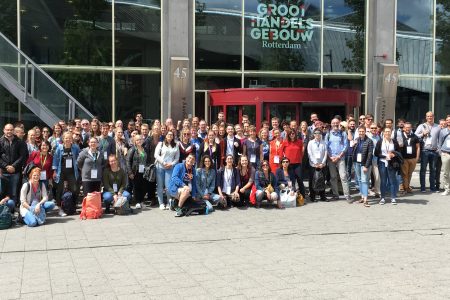Live Streaming Science?
More and more scientists are using Twitch, a popular game-broadcasting platform, for science communication and outreach. Could this platform decrease the knowledge gap between academia and society?
The Gap
There has always been a gap between the people who try to understand the fundamentals of our universe, thus generating knowledge, and the people who should understand, criticize, and benefit from this knowledge. Although this gap between academia and society has narrowed somewhat with the advent of mass media, it is always there.
We can list three concepts which have helped to bridge this gap: science journalism, popular science, and science communication. Each of them has made its own contribution to closing the gap and creating a healthy connection between academia and society. Science journalism and popular science have brought science to new audiences. Think of the pioneering work of scientists such as Carl Sagan, for instance, whose TV series “Cosmos” inspired many students -including myself- to become scientists. Science communication, on the other hand, is slightly different. Rather than selecting the most popular studies or results, it aims to describe and communicate research findings and outcomes in plain terms.
Since science communication is generally the domain of university PR offices, it still tends to use conventional media channels to disseminate information. Recently, many universities have started using social media sites, not only to reach a broader audience but also to attract the attention of adolescents, the biggest cohort that dominate the social media. Some independent organizations and YouTubers – such as Veritasium, Crash Course, SciShow, and Kurzgesagt – have also made brilliant contributions to closing the gap. However, typical YouTuber recordings usually require above-average video recording equipment, video editing, and scripting capabilities. Most of the time, scientists cannot carry out this kind of professional video production alone, alongside their main job.
New directions in science communication
Fortunately, with the advent of live streaming the tide has turned for some scientists. Since live streaming does not require as much time as a video production of pre-recorded episodes, scientists can (after a once-off cumbersome set-up process) start and stop live broadcasting with just a button. Hence, some scientists have been attracted to using Twitch (a popular game-streaming platform owned by Amazon) for science communication.
Twitch is a live-streaming platform in which broadcasters can stream diverse content. By 2015 Twitch had over 1.5 million streamers and more than 100 million viewers per month. Although the platform includes mainly gaming-related or gameplay content, in recent years new types of streaming have been introduced. “Just Chatting”, “IRL” (In Real Life), and “Science & Technology” are among the examples of categories that are becoming increasingly popular. Because these content types are outside the gaming world, they may perhaps have a more sincere and “down-to-earth” quality to them. Moreover, the broadcasting software enables streamers to create different scenes and visual layouts that resemble programmes on TV. Indeed, some of the streamers have adopted a TV-like style and have their own show formats.
What is the difference with Twitch?
In addition to being focused only on live videos, Twitch has some fundamental differences from its competitors such as YouTube. First, the interaction between the broadcaster and viewer is enhanced via various extensions. For example, if a viewer is just starting to follow you (equivalent to subscribing on YouTube) on Twitch during a live stream, an on-screen animated notification appears with sound, announcing the name of the user that has just clicked the follow button. Moreover, some on-screen overlays are even interactive for viewers. For instance, one extension that is especially useful for education streams is Quiz Kit. Using this extension, streamers can create live quiz game shows which viewers can play together by clicking on the answers.
Second, the streaming software allows the broadcaster to show virtually everything that is on their computer or on the web. This has created a new genre of “reaction streams”, where a streamer watches and responds to content on the web. What makes this particularly relevant for science communication streams is that materials from scientific software or graph/figures can be shown with the cursor and explained in great detail.
Finally, the tone of the content and quality standards are fundamentally different. While in Youtube, content is pre-recorded and it is therefore usually expected that the video content will have been edited and polished as much as possible and will have a logical flow. Therefore, if one has less-than-optimal recording conditions, equipment, or video editing, the result will not meet the unwritten/assumed visual and auditory standards. In any type of live streaming, on the other hand, since there is no time for editing or polishing, lower video or audio quality is usually found acceptable. Some would argue that it even creates a more sincere and close-to-life experience for viewers.
Live streaming science
Because of the aforementioned differences, some scientists have started using Twitch for science communication. The usual pattern is for the scientist to be a gamer him/herself already and to start using the platform for science communication in addition to their game streams. There are several good examples. First, The Midnicorn who, in her own description, is “an experimental quantum physicist by day and a science communicator and gamer by night.” She streams about not only in her field but also other scientific fields, to inspire her viewers to become scientists one day. Given that she suffers from Asperger Syndrome and Dyslexia, she is also an example of determination. Next, is Dr.Mick. He is a licensed couple & family therapist with a PhD in Human Development. On his channel he usually has gaming content, together with weekly mental health streams where he answers questions from his viewers. Another wonderful example of combining gaming with science communication is the ClimateGamers channel. The channel is run by a climate science and oceanography PhD student from MIT, Henri Drake. He streams weekly literature reviews of peer-reviewed climate science articles and plays Fortnite and climate-change-related games.
In addition to individual streamers, there are also communities and umbrella organisations where science communication streamers come together. The Knowledge Fellowship is a community that acts as a “central hub” for educational streamers and helps them to reach a broader audience. Viewers can nominate educational streamers to be on their “recommended streamers list” and this constitutes a place where viewers can find more streamers with science content.
Finally, there are some Twitch channels, not owned by a single individual, that have different science-show formats with multiple streamers who are not gamers. “Future is in the Science” - which I am a co-founder of- is an example of such a channel. In this channel, live interviews are streamed with scientists from all over the world. The difference from any other live TV interview is that viewers can submit their questions via a special chat command, and other viewers can vote for, or vote down, these questions. In addition, the guest scientists are encouraged to provide references for the answers they give. More importantly, scientists are given all the time they want to explain and answer questions at their own pace. In contrast to mainstream media interviews, this may be the most sought after feature by scientists.
Future of Science Communication
All in all, the interactive nature of Twitch, its ability to show a wide variety of content, and the lower time investment needed, make it the preferred platform of some scientists for outreach and science communication. Although it is still in its infancy, live streaming may be the medium for science communication in the future!





